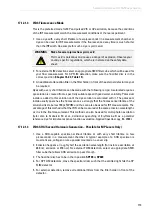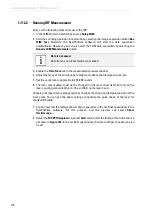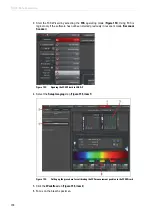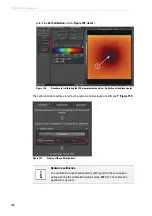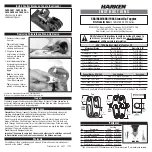
176
Summarized manual for FLIM experiments
17.13
Remarks
17.13.1
Ad-hoc-Inspection of a Specimen
For the ad hoc inspection of your specimens, you can also use the pulsed lasers in
conjunction with the internal SP8 PMT detectors. Typical pulsed lasers have a lower power
than continuous wave lasers (cw lasers). Therefore, images of weak fluorescing specimens
should be acquired at a slower scan speed.
17.13.2
Bidirectional Scanning
Bidirectional scanning is only possible for a zoom >6. The SymPhoTime software can only
partly compensate for mismatches caused by bidirectional scanning during image analysis.
The
Line Mismatch
adjustments are set in the
options...
menu, which is opened with the
options...
button. If the hysteresis effects cannot be compensated, it is preferable to perform
monodirectional scanning operations.
17.13.3
Setting the Laser Intensity of the Diode Lasers
The laser intensity of the diode lasers can be adjusted in two different ways:
• The light intensity can be reduced on the fiber coupling module (using the filter wheel
and the scaffold - or only the scaffold for direct fiber-coupled laser heads).
• The intensity can be controlled via the PDL800 or SEPIA controller. If the intensity is
changed at the PDL800 or the SEPIA, this changes the pulse shape and thus the
instrument response function (IRF). Acquire the IRF and the fading of the fluorescence
using the same laser settings on the PDL800 or SEPIA if you want to carry out another
FLIM deconvolution. The pulse width of the laser and thus the time response of the
instrument (width of the IRF) can be optimized by selecting the laser power setting at the
laser driver.
17.13.4
Sensitivity of the Fluorescence Detection
The sensitivity of the fluorescence detection of the optical system can also be increased by
opening the pinhole of the TCS SP8 in LAS AF. The signal-noise ratio and the optical
resolution can be reduced in this way.
17.13.5
Optimum Lifetime Information
In order to obtain the optimal lifetime information, it is in general preferable to scan FLIM
images with fewer pixels than standard intensity "only" images, as the accuracy of the
lifetime information is directly dependent on the number of photons per pixel. That may
become crucial if several lifetimes are present. Furthermore, the calculation time of a
lifetime image increases linearly with the number of pixels in the image. However, the
SymPhoTime software also enables you to perform post-acquisition pixel binning for
optimization of the best compromise between lifetime accuracy and resolution.
Summary of Contents for TCS SP8 SMD
Page 1: ...10 Living up to Life User Manual Leica TCS SP8 SMD for FCS FLIM and FLCS ...
Page 4: ...4 Copyright ...
Page 14: ...14 Contents ...
Page 18: ...18 Intended Use ...
Page 20: ...20 Liability and Warranty ...
Page 28: ...28 General Safety Notes ...
Page 32: ...32 Additional Notes on Handling the System ...
Page 44: ...44 System Overview and Properties ...
Page 60: ...60 SMD Components Figure 31 DSN 102 Dual SPAD Power Supply ...
Page 80: ...80 Safety Features ...
Page 102: ...102 Switching On the System ...
Page 116: ...116 LAS AF ...
Page 214: ...214 Changing the Specimen ...
Page 216: ...216 Changing the Objective ...
Page 238: ...238 Switching Off the System ...
Page 242: ...242 Repairs and Service Work ...
Page 244: ...244 Maintenance ...
Page 246: ...246 Disassembly and Transport ...
Page 248: ...248 Disposal ...
Page 254: ...254 Contact ...
Page 256: ...256 Recommended Literature ...
Page 266: ...266 Appendix Figure 225 Declaration of conformity ...
Page 268: ...268 Appendix ...
Page 269: ......












